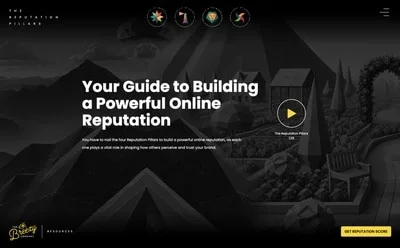Consider this: approximately 15% of the global population (that’s over a billion people) live with some form of disability. When we talk about disabilities and website accessibility, we’re not just talking about the more severe cases. Disabilities come in all forms, some visible, others not. This is why ensuring your website is accessible to all users is not just a good practice — it’s a global responsibility.
Hearing impairments, color blindness, ADHD, and Autism are just a few disabilities that could impact how users engage with your website. This means that prioritizing website accessibility needs to be a huge consideration when building and maintaining your website.
By prioritizing website accessibility, you’re not just creating a seamless experience for all users, you’re also opening the doors to millions of potential customers who might otherwise be unable to engage with your content. This inclusivity can lead to increased site traffic, higher engagement, and, ultimately, a boost in your sales and revenue.
But web accessibility isn’t just about increasing your traffic and engagement—it’s about demonstrating a commitment to every user’s experience.
How to Make Your Website Accessible

Various countries enforce laws and regulations, such as the Americans with Disabilities Act (ADA) in the U.S. and the Accessibility for Ontarians with Disabilities Act (AODA) in Canada, so ensuring your website meets these standards is crucial.
While there might not be a law in your specific country requiring website accessibility, that doesn’t mean there are no consequences for non-compliance. In the US, for instance, the Americans with Disabilities Act (ADA) can be used to enforce website accessibility. Non-compliance can lead to costly lawsuits, fines, and significant damage to your brand’s reputation.
4 Ways to Ensure Content Accessibility
Making your website easy for everyone to use is not just a one-time effort—it’s an ongoing process.
So, how can you make sure that your website is accessible to all users?
To ensure your site is accessible to all, including people with disabilities, you should follow the Web Content Accessibility Guidelines (WCAG) provided by the World Wide Web Consortium.
Here’s a simple breakdown of what these guidelines entail and how you can apply them to your website:
1. Perceivable
Your site needs to present information in a way that users can perceive, regardless of their sensory abilities. Not everyone can see images or videos, so offering alternatives like text descriptions or audio is crucial. This ensures that everyone, including those who use screen readers, can understand your content.
Here’s how you can make your website perceivable:
- Provide text alternatives for non-text content (images, videos, etc.)
- Provide captions and transcripts for audio/video content
- Make content presentable in different ways without losing meaning
- Make it easier for users to see and hear content
2. Operable
Anyone should be able to navigate and use your website easily. This includes moving from one page to another, selecting menu items, or playing videos. Keep your website simple and intuitive to make sure it can be used by people with various disabilities, like those who cannot use a mouse.
Here’s how you can make your website operable:
- Make all functionality available from a keyboard
- Give users enough time to read and use content
- Avoid flashing animations over a specific rate that can cause physical reactions
- Help users navigate and find content by using clear headings and titles
3. Understandable
Your site’s information should be easy to understand. Clear language and a logical layout are critical to making sure your site is accessible. Consider visitors who might have cognitive disabilities or who are not fluent in your website’s primary language.
Here’s how you can make your website understandable:
- Make text readable and understandable by using clear and simple language
- Make content appear and operate in predictable ways
- Help users avoid and correct mistakes by showing error validation or suggesting fixes for form errors
4. Robust
Your website should work well with different technologies, including screen readers and other assistive tools. Writing clean, standard HTML helps these technologies interpret your site correctly.
Here’s how you can make your website robust:
- Maximize compatibility with current/future technologies
- Ensure accessibility for assistive technologies by adding ARIA roles and labels for screen readers
Remember: It’s not enough for your website to be usable if it doesn’t meet these four criteria. So, continuously updating and testing your site is not just a one-time effort but an ongoing process. This commitment to accessibility ensures the sustainability of your efforts as technology changes.

Website Accessibility Can Enhance Your Brand Image
Web accessibility is not just a nice-to-have — it’s essential and should be a foundational aspect of your website design.
Today’s consumers value ethical, socially responsible brands. Making web accessibility a central element of your website sends a clear message to your visitors: you value each person’s experience and are committed to accommodating all users.
This commitment to inclusivity can significantly enhance your brand’s perception and foster greater customer loyalty. A brand that champions accessibility demonstrates leadership and care, attracting those who directly benefit from these features and their friends, family, and advocates.
But while we highlighted that there are strategic benefits to having an accessible website, we want to stress that the strategic benefits isn’t the only reason why you would prioritize accessibility.
Your website should be accessible to all users because it’s the right thing to do.
As website owners, we have a duty and a commitment to ensure that our digital spaces are inclusive and welcoming to everyone.
Improved Usability for All Users

It’s clear that when businesses prioritize accessibility, everyone benefits. Whether you’re designing your first website or updating the one you have, be sure to make it inclusive for every user.
Making website accessibility a priority ensures that everyone—regardless of their abilities—can have a smooth and inclusive experience on your site. This opens up your content to millions of potential customers who might otherwise face barriers and enhances site traffic, engagement, and, ultimately, your bottom line.
Just remember that web accessibility goes beyond boosting numbers. It shows a genuine commitment to the experience of all your users.
Your Website Should Be As Great As Your Business Is
Ok, you keep hearing that your website is the front door of your business but you just don’t see it. Most of your business comes from referrals and your website is just there. This limits you at only being able to reach the people you can yourself. On top of the fact that when the people you meet see your site, it gives an impression of what it will be like working with you.
You should be confident that your site is up to date, searchable on Google and tells the story as well as you do.
The problem is that your nephew doesn’t have enough experience, you have to manage the freelancer and you don’t want to pay for an expensive site redesign.
The truth is you’re tired of having a website that breaks and is not generating business.
Maintaining your website should be easy. Now it can be. Reach out to learn more about how our team can help you today!
- Category: Sites
- Tags: User Experience
Steve Soto: SEO & Website Performance Insights at Breezy
Steve Soto is a seasoned CTO and Partner at The Breezy Company. With deep expertise in software architecture and executive-level product development, he empowers teams to scale with smart, secure digital systems.
Read more articles by Steve Soto



